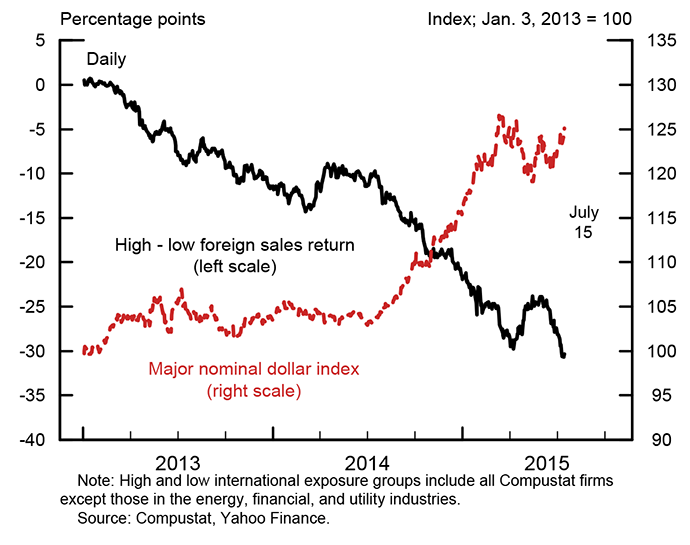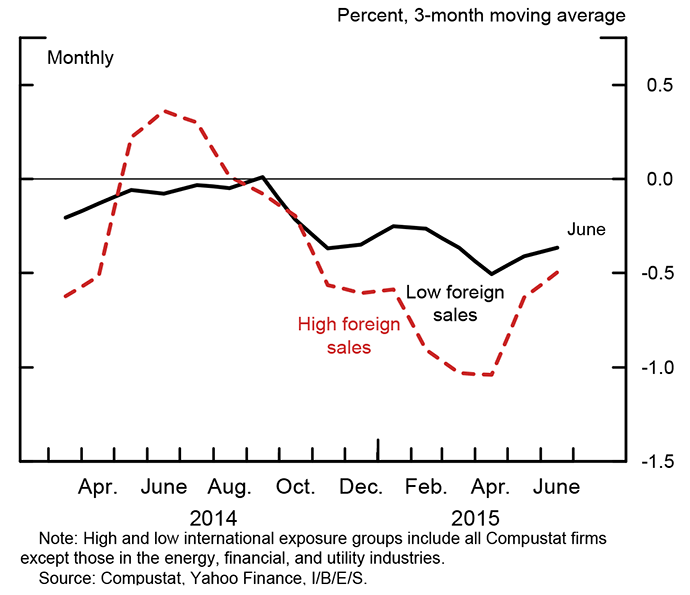IFDP Notes
July 17, 2015
How much has dollar appreciation affected U.S. corporate profits?
Carol Bertaut and Nitish Sinha
1. Introduction
U.S. corporate profits fell about 1.4 percent in the fourth quarter of last year and, based on estimates from the Bureau of Economic Analysis (BEA), declined a further 5.2 percent in the first quarter of 2015. In part, this weakness reflects a decline in profits of the energy sector, which have been hurt by the decline in oil prices. But the strength of the U.S. dollar since last summer has also had a sizable effect. Dollar appreciation can lower profits of U.S. corporations through two channels: (1) If unhedged, profits earned by firms' foreign subsidiaries translate into fewer U.S. dollars, and (2) U.S. exports become less competitive compared with goods produced in other countries. We assess how the dollar's recent strength may have affected corporate profits of firms with different degrees of international exposure first by looking at information from financial markets, and second by looking at model-based estimates of the effect of the dollar specifically on income earned by foreign affiliates.
2. Information from financial markets
Over the past several months, equity investors appear to have been factoring the effects of dollar appreciation into their expectations for corporate earnings and portfolio allocation decisions. The black line in Figure 1 shows the difference between the stock returns of firms with high foreign sales (that is, firms with at least 50 percent of revenue earned abroad, directly or through exports) and low foreign sales (that is, firms with less than 20 percent of sales abroad). To isolate the effect of the dollar, we exclude oil firms.1 While the shares of firms with high foreign sales underperformed in 2013, their relative performance worsened as the dollar (the red line) began to appreciate last summer. The relative underperformance has continued to follow the dollar's movements, and on net since last summer, returns of high foreign sales firms are about 20 percent below those of firms with low foreign sales.
Wall Street analysts also appear more concerned about earnings prospects for firms with high foreign exposure. As shown in Figure 2 and focusing again on nonfinancial firms outside of the oil sector, S&P 500 firms with high foreign sales have experienced larger downward revisions to year-ahead earnings expectations in eight out of 12 months over the past year than have firms with lower exposure. These downward revisions were especially pronounced late last year and early this year. Having said that, recent data suggests a similar level of revision for both high and low international exposure groups, consistent with the relative stability in the U.S. dollar of late.
3. Model-based estimates of earnings of foreign subsidiaries
The earnings of U.S. foreign subsidiaries account for about 25 percent of the overall profits of U.S. nonfinancial corporations. According to the BEA, U.S. direct investment receipts, a concept roughly equivalent to earnings of U.S. foreign subsidiaries, declined 2.5 percent in the fourth quarter of 2014 and fell a further 7.7 percent in the first quarter of 2015. This decline contributed importantly to the weakness in U.S. corporate profits over these two quarters.
On a quarterly basis, direct investment income is not available at an industry breakdown comparable to the non-financial sector excluding oil and utilities shown above for financial market analysis. To gauge how much of the decline in income from foreign affiliates over the past two quarters owes to the dollar's strength and how much to other factors such as the decline in oil prices, we use information from the staff's model for the direct investment income component of the staff's comprehensive partial-equilibrium model for U.S. international transactions (USIT model).2
Direct investment income receipts in the model depend on the exchange value of the dollar, the foreign output gap, and the relative price of imported oil. Since last summer, the most important developments for the evolution of direct investment receipts were the dollar's appreciation and the decline in oil prices. As noted in the table, based on the USIT model's coefficients, a 10 percent appreciation of the dollar (as measured by the Board's major currencies nominal index) reduces current direct investment receipts by nearly 4 percent. A $1 decrease oil import prices reduces receipts by .22 percent. Between end-September 2014 and end-March 2015, the dollar appreciated 14.9 percent and the oil import price fell by $41.1. Taken together, these two factors would generate a decline in direct investment income receipts of about 14-1/2 percent, with a little more than a third (-5.6 percent) accounted for by the dollar's appreciation.
| Table 1. Effects of dollar appreciation and a decline in oil prices on U.S. direct investment receipts in the Board’s USIT Model |
|---|
| 10% dollar appreciation (major currencies nominal index) | $1 fall in oil import prices | Combined effect | |
|---|---|---|---|
| Effect on DI receipts | -3.80% | -0.22% | |
| actual changes, 2013Q3-2015Q1 | 14.90% | -$41.10 | |
| Implied effect on DI receipts | -5.60% | -9.00% | -14.60% |
4. Conclusions
Overall, we find that the recent appreciation of the U.S. dollar has had a significant effect on U.S. firms' profits, especially for firms with high foreign sales. The dollar's strength likely explains roughly a third of the recent decline in profits earned from foreign subsidiaries. But an encouraging sign from financial markets is that much the effect of the dollar's appreciation since last summer may have already shown through to U.S. corporate profits, given the recent stability in stock prices of internationally exposed firms and in the analysts' expectations.
1. Firms with high foreign sales tend to be larger and account for almost 75 percent of S&P 500 nonfinancial earnings excluding oil and utilities. We also exclude utilities firms because they typically pay high dividends and so their stock returns are typically closely tied to movements in bond markets. Return to text
2. Further background including key equations from the USIT model is available in Bertaut, Kamin, and Thomas (2008), "How Long Can the Unsustainable U.S. Current Account Deficit Be Sustained?," Board of Governors of the Federal Reserve System, International Finance Discussion Papers No. 935. Return to text
Please cite as:
Bertaut, Carol C., and Nitish Sinha (2015). "How much has Dollar Appreciation Affected U.S. Corporate Profits?" IFDP Notes. Washington: Board of Governors of the Federal Reserve System, July 17, 2015. https://doi.org/10.17016/2573-2129.10
Disclaimer: IFDP Notes are articles in which Board economists offer their own views and present analysis on a range of topics in economics and finance. These articles are shorter and less technically oriented than IFDP Working Papers.


